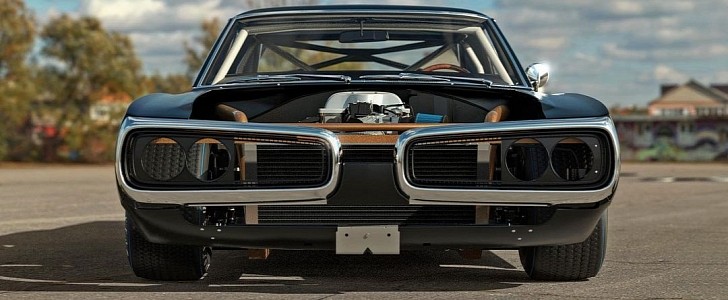We might think that designers and engineers have very clear roles, but what if these were to be switched for a digital art project? The rendering we have here, which introduces a radical take on the muscle icon that is the Dodge Super Bee, does just that.
Dodge introduced the Super Bee back in 1968, as its muscle-on-a-budget proposal based on the Plymouth Road Runner. And no model is easier to spot than the 1970, with this one receiving a twin-looped front bumper.
Well, digital artist Abimelec Arellano has decided to build on the unapologetically badass design of the American toy, albeit while completely redefining the tech side of the contraption.
Thus, the front end now only holds the elements that define the look of the car, while mixing these with large open sections. As the artist explains in the first Instagram post below, the inspiration came from an uber-mean 1973 Plymouth Barracuda real-world build you'll see in the second post (this one spends its days over in New Zealand).
Besides, extra cooling was required, since this Dodge is now a Hellcat vessel, but there's no reason to worry about the iron block messing up the weight distribution of a project that aims for brilliant all-round driving dynamics. That's because the 6.2-liter HEMI has been relocated, as this is now a mid-front-engined machine.
That change doesn't sound so unusual when you consider that, underneath the Super Bee body, we find a NASCAR chassis, with the wheel wells having received plenty of fabrication work for the car to sit closer to the asphalt.
Speaking of which, this Dodge now talks to the road/track via NASCAR-style steelies (the chrome bits are on the house) shod in period-correct Goodyear Blue Streak tires (the threaded vintage rubber was borrowed from the Ford GT40).
Of course, such a virtual build couldn't keep the factory interior. For starters, moving the engine required repositioning the firewall.
And you should know that the top pad of the dash is one of the few elements linking this Super Bee to its stock form: the motorsport-grade piece of metal serving as the dash houses three gauges that keep things simple for the driver. And while the road car seats stick to the half-a-century-old theme, a massive roll cage is there just in case things go south.
Now, the immersive nature of the pixel work also comes from the details, with the artist explaining the creation process: "I love these type of exercises as they make me think in solutions outside of just making a car look nice, like all the tubing for the front, radiator hoses, engine placement, angle, etc. Not an engineering piece by any means, but fun nonetheless!"
Well, digital artist Abimelec Arellano has decided to build on the unapologetically badass design of the American toy, albeit while completely redefining the tech side of the contraption.
Thus, the front end now only holds the elements that define the look of the car, while mixing these with large open sections. As the artist explains in the first Instagram post below, the inspiration came from an uber-mean 1973 Plymouth Barracuda real-world build you'll see in the second post (this one spends its days over in New Zealand).
Besides, extra cooling was required, since this Dodge is now a Hellcat vessel, but there's no reason to worry about the iron block messing up the weight distribution of a project that aims for brilliant all-round driving dynamics. That's because the 6.2-liter HEMI has been relocated, as this is now a mid-front-engined machine.
That change doesn't sound so unusual when you consider that, underneath the Super Bee body, we find a NASCAR chassis, with the wheel wells having received plenty of fabrication work for the car to sit closer to the asphalt.
Speaking of which, this Dodge now talks to the road/track via NASCAR-style steelies (the chrome bits are on the house) shod in period-correct Goodyear Blue Streak tires (the threaded vintage rubber was borrowed from the Ford GT40).
Of course, such a virtual build couldn't keep the factory interior. For starters, moving the engine required repositioning the firewall.
And you should know that the top pad of the dash is one of the few elements linking this Super Bee to its stock form: the motorsport-grade piece of metal serving as the dash houses three gauges that keep things simple for the driver. And while the road car seats stick to the half-a-century-old theme, a massive roll cage is there just in case things go south.
Now, the immersive nature of the pixel work also comes from the details, with the artist explaining the creation process: "I love these type of exercises as they make me think in solutions outside of just making a car look nice, like all the tubing for the front, radiator hoses, engine placement, angle, etc. Not an engineering piece by any means, but fun nonetheless!"











